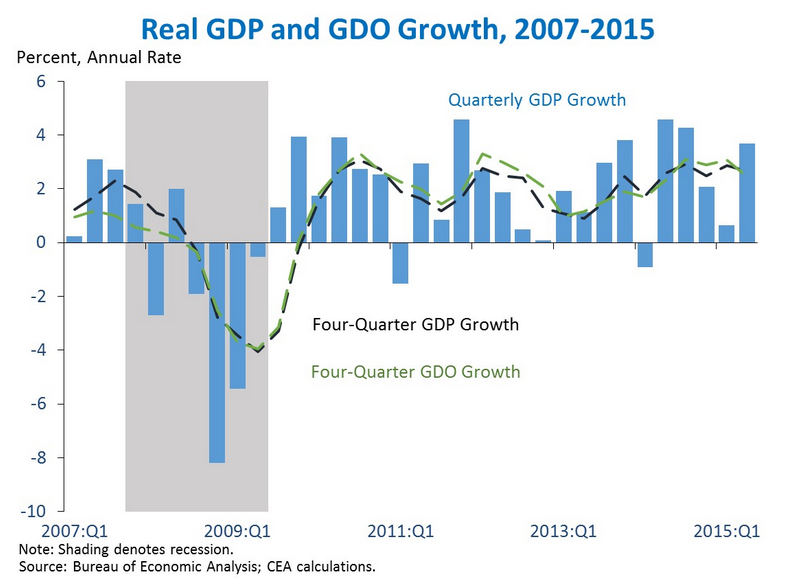The Obama administration got a double dose of good economic news on Thursday as stock markets continued to rally back from a frightening week of steep declines and the Bureau of Economic Analysis released an updated reading on second-quarter GDP showing the economy grew at a much faster pace than previously believed.
The BEA, which had issued a preliminary estimate of annualized Gross Domestic Product growth of 2.3 percent, revised the initial number up dramatically, to 3.7 percent. That far eclipsed the disappointing 0.6 percent rate for the first quarter of the year, which reflected an unusually harsh winter.
Related: Why You Should Ignore the Stock Market Selloff
The single biggest contributor to the change was an increase in business fixed investments, which alone accounted for 0.5 percentage points of the movement. Inventory investment and spending by state and local governments also contributed, moving the estimate upwards by 0.3 percentage points each.
The news was especially welcome to the Obama administration, which has been pushing a narrative of continued strong economic growth for months.
In a blog post on the White House website, Council of Economic Advisers Chairman Jason Furman also took the opportunity to call on congressional Republicans to pass a budget for the next fiscal year without taking the country to the brink of default.
“At this time in the global economy, it is essential that we continue to do everything we can to maintain America’s domestic economic momentum —including avoiding a return to fiscal brinksmanship or unnecessary austerity by passing an on-time budget that reverses the sequester, increasing investments in infrastructure as part of a long-term transportation reauthorization, and other steps to foster long-term growth,” Furman wrote.
Related: Why China’s Slowdown Will Lead to Sustainable Growth
Heading into a presidential election year, the news also offered some hope to the Democratic Party that a more vibrant economy might make selling the public on a Democratic replacement for the current Democratic president a bit easier.
However, a surging economy is one more data point on which the Federal Reserve Board’s Open Market Committee will base its decision next month on whether to begin the process of increasing interest rates from their current near-zero level. Messages surrounding the Fed’s intentions have been clouded, to say the least, in the past week, and the good GDP news does little to clear up the picture.
Related: The Troubling Truth Revealed by the Stock Market’s Nosedive
Conventional wisdom had it that in the face of the global stock sell-off that began last week, Fed policymakers would be much less likely to begin raising rates in September. The resurgence of share prices on Wednesday and Thursday raised some doubts about that increasingly popular line of thinking.
Now, with evidence from the BEA that the economy may be heating up again, the FOMC will have to balance its decision between the desire to head off what some have predicted will be a dramatic rise in inflation and the need to keep the economy strong enough to generate steady job and, eventually, wage growth.





